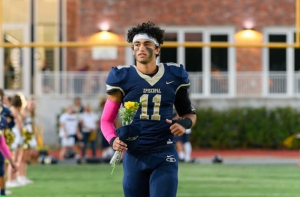Music Column: Chart toppers change through the context of time
October 3, 2018
I am often told by older music lovers that the music I fell in love with in my late-high school to early college years is going to be the bulk of the stuff that sticks with me forever. I think a lot about this and how I feel as a dynamic listener already throughout these three or so years I have experienced through this timepath.
How have tastes changed? What grew and what shrunk? How did the context of how I felt at the time change my perception of what was going on in the songs? These are the questions I find I continually have to ask myself as somebody always wanting more from the listening experience.
What it boils down to is that most music will not always sound the same as it did when you first heard it. However, the sounds that do can be labeled as timeless and should be cherished.
Last week, online music publication powerhouse Pitchfork released their updated list of “Top 200 Albums of the 1980s” for the first time since 2002. What I noticed was that they really tried to put a modern-day cultural lens on the top of the list, including a wider array of racial and gender diversity as compared to 16 years ago.
The top 10 from 2002 included only one non-white artist (Public Enemy) and included zero female artists. The updated top 10 from 2018 includes six black artists and three female artists. This is a clear editorial shift that focuses on a more all-inclusive music scene than that of the early 2000’s.
It makes sense, of course. What were the stepping stones to make trap the dominating genre as we conclude the century? That timeline didn’t start with R.E.M. and The Smiths. Absolutely not. However, I don’t necessarily think it started with Prince and Michael Jackson, who placed first and second on the updated list, either.
As a culture, the current state of popular music is so far removed from the 1980s that it’s extremely hard to pinpoint what influences are derived in which songs or albums anymore.
Prince’s “Purple Rain” jumped from spot number 12 to spot number 1, which, given the cultural shift of the publication makes entire sense. What I fail to understand is how “Purple Rain” had more of an impact on 2018 music than 2002 music. The example is taken even further with “Thriller” jumping from spot 27 in 2002 (what on earth were they thinking?) to number 2 in 2018. I hear a lot more “Thriller” influence in 2002 chart-toppers by Nelly or Usher than in the 6ix9ine or Juice Wrld songs that sit high today.
The most baffling take on the list was to replace Beastie Boys’ “Paul’s Boutique” at number 3 with NWA’s “Straight Outta Compton.” “Paul’s Boutique” is a master-craft in sampling, flow, cohesiveness within a group, culture and genre-bending ideas. It is a flawless piece of art. “Straight Outta Compton” is a mediocre album with three singles that remain iconic but mislead the entire listening experience.
What I think Pitchfork wanted to do here was say that NWA paved the way for culturally important rap collectives that have come onto the scene since 2002 such as Odd Future, Black Hippy and Brockhampton. What they entirely fail to realize is that Beastie Boys did that so much better. Sure, the members of NWA went on the have more sustaining solo careers much like the members of Odd Future would mimic in an eerily similar fashion. But that should not change the legacy of a perfectly crafted album. The context of what happens as a result of a group should never tarnish the precision of an album at its time. “Paul’s Boutique” is simply a better album in every sense of judgement.
Ranking albums is always hard. People have a different connection to different sounds and narratives for different reasons. I’ve never fully agreed with a list I’ve read, nor should you. That’s what makes it fun.
The only three albums that made the top 10 in both lists were Talking Heads’ “Remain In Light,” Sonic Youth’s “Daydream Nation” and Public Enemy’s “It Takes a Nation,” all three of which have undeniably made massive impacts and arguably shaped the sounds of their respective genres. These are the timeless albums, the ones that are never going away. Every album of a “top of the century” list has some sort of impact, but if it can manage to be huge in the 80s, in 2002 and 2018, then it’s simply timeless. There is no debate.
The context of time relating to what from the past is “best” now is fascinating. It’s merely a subjective stance, but thought-provoking nonetheless. Is Prince really still the best? Has he always been since “Purple Rain” came out? What will people think of it in 20 years? One hundred years? All questions that can be analyzed and argued for hours on end. That’s what makes music so cool.









![NEWS | The University of Alabama issued guidelines for faculty that align with the passage of SB129, a controversial Alabama state law that, among other things, restricts DEI policies and prohibits endorsements of “divisive concepts.” These new guidelines highlight potential interactions with “divisive concepts” and formalize a new list of do’s and don’ts for classroom discussion and instruction.
From the start of the fall semester, SB129’s impact could be felt across campus, from the changes to funding for student organizations to the shuttering of the Safe Zone and offices of the Black Student Union. These outcomes were the result of SB129’s anti-DEI sections, preventing the University from sponsoring or promoting any DEI programs. The consequences of SB129’s “divisive concept” restrictions were more uncertain, however.
“[SB129] is vague, and what its implications will actually look like are not totally clear,” said Beth Ann Powers, an associate member in the University of Cincinnati Law Review.
Read the full story at the link in our bio.
📸 CW / Riley Thompson
🖊️ CW / Benjamin Smith
#theuniversityofalabama #universityofalabama #alabama #uofa #ua #crimsontide #tuscaloosa #tuscaloosaalabama #alabama #bama](https://thecrimsonwhite.com/wp-content/plugins/instagram-feed/img/placeholder.png)